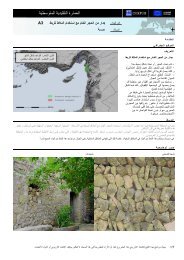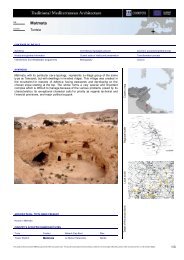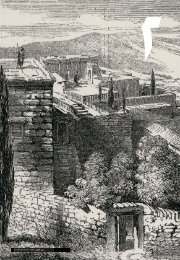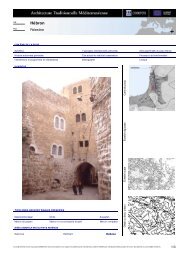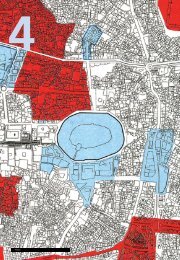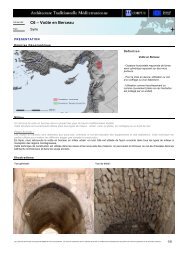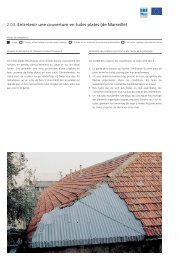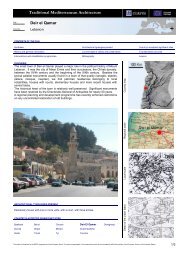Ghazir - CORPUS - Euromed Heritage
Ghazir - CORPUS - Euromed Heritage
Ghazir - CORPUS - Euromed Heritage
You also want an ePaper? Increase the reach of your titles
YUMPU automatically turns print PDFs into web optimized ePapers that Google loves.
Traditional Mediterranean ArchitectureSite :Country :<strong>Ghazir</strong>LebanonCONTENTS OF THE FILESynthesis Architectural typologies present Country’s accepted significant sitesHistory and general information Current state of vitality and preservation Transformation processInterventions and rehabilitation programmes Bibliography LexiconSYNTHESISIn the XVIIIth and XIXth centuries, the town of Kesrouan played a significant role inthe political history of Lebanon, and was used as headquarters by feudal lords.With the creation of the Lebanese Republic, the town lost its primary role. It hasnow become a secondary summer holiday resort. At the beginning of the 1975-1990 war, Christians moved towards Kesrouan: this great increase in populationaffected the site and its traditional urban fabric. The Municipality was totally unableto cope with a change of that extent.<strong>Ghazir</strong> is a standard XVIIIth century town on Mount Lebanon, a headquarter forpower long before the Tanzimats. One can find elementary rural houses, houseswith iwan, as well as houses with central lobbies, common amongst the XIXthcentury aristocracy and local middle-class.Local scaleRegional scaleCountry mapARCHITECTURAL TYPOLOGIES PRESENTElementary house, iwan, three arches.COUNTRY’S ACCEPTED SIGNIFICANT SITESDetail of the urban fabricBaalbeck Beirut Choueir Deir El Qamar DerdghayaDouma <strong>Ghazir</strong> Menjez Ouadi QadishaSaida Tripoli Tyr YounineThis project is financed by the MEDA programme of the European Union. The opinions expressed in the present document do not necessarily reflect the position of the European Union or of its member States. 1/3
Traditional Mediterranean ArchitectureHISTORY AND GENERAL INFORMATIONIn the XIIth century, the Mamelukes invaded Kesrouan and destroyed villages and towns, amongst which <strong>Ghazir</strong>. At the time,<strong>Ghazir</strong> was only a small village. In the XIVth century, the army of Soleiman Bin Arab the Turc settled in <strong>Ghazir</strong> to keep watch onthe sea route between Tabarja and Nahr el Kalb. In 1516, Sélim, the ottoman sultan after vanquishing the Mamelukes, appointedPrince Assaf Turcoman governor of Kesrouan. The prince made <strong>Ghazir</strong> his capital and centre for his authority. <strong>Ghazir</strong> was thenenriched with numerous constructions: a seraglio was built on the site of Saint-Francis convent, a mosque, gardens and baths.Hydraulic installations were also brought. After the death of Prince Assaf, in 1580, the Saifa family took over the town and droveout the Hobeich family, allied to the Assaf.In 1711, the Chéhab, governors of the Mount Lebanon, came to power and settled in <strong>Ghazir</strong>. In 1804, prince Hassan Chéhabbegan the construction of a palace, a qaysaria and a souk for regional trade. Till the end of the XIXth century, <strong>Ghazir</strong> was apolitical and economic centre. Several typical XIXth century houses with three arches were built. In 1905, a new seraglio wasbuilt by Mouzaffar Bacha, the Ottoman moutasarrif of Mount Lebanon. The town declined in the wake of the XXth century, whenthe whole territory was reorganized.⎯ Surface area of the site 535 Ha⎯Geographical co-ordinates⎯ Height above sea level 0 to 450 m⎯ Lithology Regular limestone beds, marlylimestone⎯ Population 27 000 inhab, 9.000 of whom arefrom <strong>Ghazir</strong>⎯ Population density 70 inhab/Ha⎯ Average annual maximum temperatures 22,3ºC⎯ Average annual minimum temperatures 13,9ºCGeneral view⎯ Average of maximum temperaturesduring the hottest month for ten years⎯ Average of maximum temperaturesduring the coldest month for ten years41,8ºC-2°C⎯ Average rainfall 1.071 mm⎯ Average number of days of rain per year 81 days⎯⎯⎯⎯Specific characteristics<strong>Ghazir</strong> towers above the Jounieh bay, one of the most beautiful sites inLebanon. The town has a bridge from Roman times, 19 old water mills, anOttoman seraglio, a qaysariya and many hiking paths. Some monuments arelisted and protected.Traditional economic activitiesSilk production (now disappeared) and wine, tapestry, ironwork, straw chairmanufacturing and oil presses.New economic activitiesSummer resort, small businesses.Site’s communications with its territoryLocated in the mohafazat of Mount Lebanon, caza of Kesrouan, 27km north ofBeirut.House with arcadePedestrian streetThis project is financed by the MEDA programme of the European Union. The opinions expressed in the present document do not necessarily reflect the position of the European Union or of its member States. 2/3
Traditional Mediterranean ArchitectureCURRENT STATE OF VITALITY AND PRESERVATIONBeing a summer resort, <strong>Ghazir</strong> is liveliest during summer. The consequences ofreal-estate speculation are a constant threat to the traditional harmony of the town.No heritage preservation policies or measures have been taken by local authoritiesof yet. Only a few buildings were classified by the Directorate-General of Antiquities.A few works of restoration were undertaken on a purely private level, without anyrespect for traditional know-how.TRANSFORMATION PROCESSAfter the creation of the Lebanese Republic, <strong>Ghazir</strong> ceased being a local authorityand lost its primary role in the hierarchy of mountain towns. During the 1975-1990war, many modern buildings were built in <strong>Ghazir</strong>, destroying the traditional stylishheritage it had maintained till the 1960s.The roads which now go through the old town were built in place of many traditionalhouses and part of the old souk. The continuity of traditional staircases between lowand high districts was broken.Furthermore, there is no rain water drainage, which regularly deteriorates theroadway system. In the short term, no global management policy seems to beconsidered.INTERVENTIONS AND REHABILITATION PROGRAMMESSpecific municipal preservation measures are in process to rehabilitate: the PrinceAssagi mosque, the seraglio, the souk. These measures also include new streetpavement and parks, but municipal means are insufficient for this deteriorating site.ContactsMr Roland Haddad, architect, restorerBIBLIOGRAPHYLEXICONTanzimat: Ottoman administrative reform programQaysariya: large square building organized around a court for the production and trade of silk.Moutasarrif: Ottoman province governor.File created: 07.08.2003 Last modified: 10.12.2003This project is financed by the MEDA programme of the European Union. The opinions expressed in the present document do not necessarily reflect the position of the European Union or of its member States. 3/3





